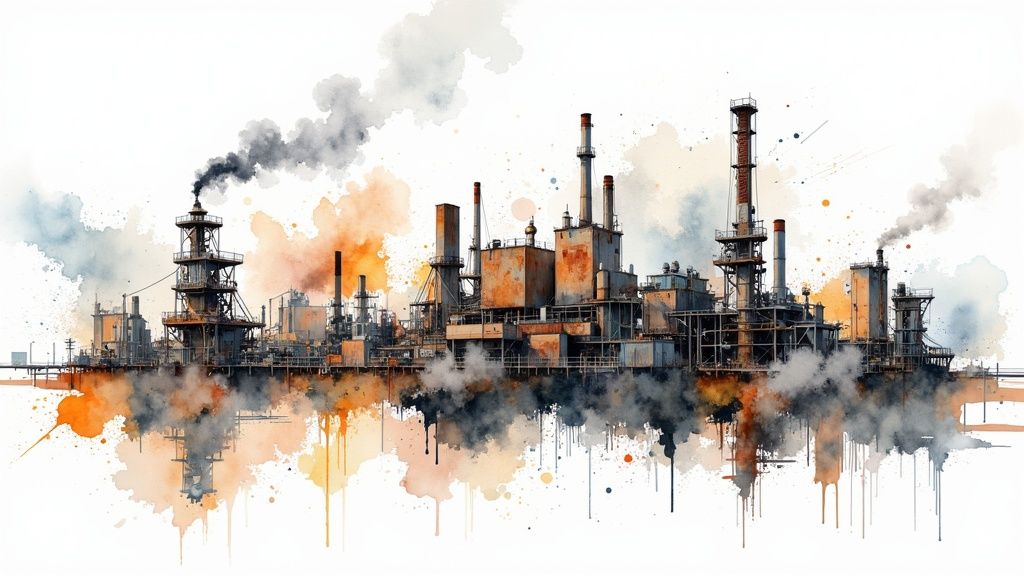The Evolution of Production Capacity Planning

The way companies plan their production capacity has changed dramatically over time. In the early days, manufacturers relied mostly on basic scheduling and gut feelings to predict how much they needed to produce. This simple approach often led to problems - too much inventory sitting around or not enough products to meet customer demand.
The Industrial Revolution marked a key turning point. As more people started buying manufactured goods, companies had to get better at meeting growing demand. Henry Ford introduced the assembly line, which was a game-changer - his Model T could now be built much faster than before. While this was a huge step forward, planning was still done mostly by hand with paper and pencil. You can learn more about early capacity planning methods at NetSuite's resource center.
From Manual Calculations to Data-Driven Insights
The switch from manual planning to computer-based systems changed everything. The old way involved hours of tedious calculations using limited historical data, which often resulted in wrong forecasts. When companies started using computers and specialized software, they could analyze much more information and spot patterns they couldn't see before. This helped them make smarter decisions about their production needs.
The Rise of Integrated Planning Systems
Today's manufacturers use systems that connect all parts of their operations. These tools give them a complete view of their production capacity by considering things like:
- Available materials and supplies
- Worker skills and schedules
- Equipment maintenance needs
For example, if a supplier runs late with a delivery, the system can quickly adjust production schedules to minimize disruption. Different departments can now work together more smoothly since they all see the same information in real time. This connected approach helps companies be more flexible and efficient with their resources. As technology keeps improving, we'll likely see even better ways to plan and optimize production in the future.
Navigating Modern Manufacturing Challenges

Manufacturers face serious challenges in planning and managing their operations effectively. The rise in frequent market shifts has made production capacity planning essential for success. Companies need to move beyond basic forecasting to build flexible systems that can quickly adapt when conditions change.
Responding to Demand Volatility
Unpredictable customer demand creates major headaches for manufacturing operations. When order volumes swing unexpectedly, facilities often struggle to adjust their output levels appropriately. Too much production wastes resources and creates excess inventory, while too little means missed sales and unhappy customers. A facility running near full capacity can quickly become overwhelmed when demand spikes without warning.
Building Supply Chain Resilience
Supply chain problems have become a regular occurrence that complicates production planning. Material shortages, shipping delays, and cost increases can derail even carefully laid production schedules. Manufacturing companies need backup suppliers and robust contingency plans to maintain operations when issues arise. However, traditional planning methods based on historical averages achieve only a 50% success rate in meeting demand targets. During the pandemic, this weakness became clear as 97% of industrial companies reported problems with their capacity planning. Learn more about demand-driven planning approaches at SafetyChain's detailed analysis.
Overcoming Resource Constraints
Managing internal resources effectively remains challenging even with good forecasts and reliable suppliers. Key factors include:
- Maximizing equipment efficiency
- Scheduling workers appropriately
- Maintaining adequate materials
These limitations often create bottlenecks that restrict total production capacity and cause delays. Success requires understanding these constraints and developing ways to optimize resource use. Smart manufacturers focus on eliminating waste through lean methods and selective automation to improve output. Taking action early based on data insights helps prevent small issues from becoming major disruptions.
Mastering Essential Capacity Calculations

Understanding your production capacity is essential for running an efficient manufacturing operation. It goes beyond just knowing maximum output numbers - you need clear insights into your resources, processes, and potential bottlenecks. This knowledge helps you make better decisions about your production line.
Key Metrics in Capacity Planning
When planning production capacity, focus on these core metrics:
- Design Capacity: The maximum possible output under perfect conditions - your production line's full potential
- Effective Capacity: Your realistic output after accounting for maintenance, shift changes, and planned downtime
- Actual Output: What you really produce each day, which can vary due to equipment issues or material delays
These metrics work together to give you a complete picture of your production capabilities. By tracking them consistently, you can spot problems early and set achievable targets for your team.
Calculating Production Capacity for a Single Product
For one product, capacity calculations can be simple. You might be interested in: How to master data analytics. Just divide your total production time by how long it takes to make one unit. For example, if you have 480 minutes of daily production time and need 2 minutes per unit, you can make 240 units per day. But real production often brings extra challenges that affect these numbers.
Multi-Product Capacity Planning
Managing capacity for multiple products needs more detailed planning. One useful method is looking at your total machine hours and comparing them to each product's production time. Take a beverage plant making both soda and beer - if soda takes 6 seconds to can and beer takes 9 seconds, with 2400 minutes of weekly machine time, you can figure out exactly how many of each you can produce. Learn more at mrpeasy.com. Getting these calculations right helps you schedule production efficiently.
Analyzing and Interpreting Capacity Data
Doing the math is just the start - you need to understand what the numbers mean for your business. Look for bottlenecks, ways to improve schedules, and whether you need new equipment. Regular monitoring helps you spot issues before they become problems and keeps your production running smoothly.
Leveraging Advanced Planning Technologies

Manufacturing companies are adopting smart planning tools to boost their production capacity management. These systems help companies stay ahead of production challenges instead of just reacting to problems. The right tools make it easier to plan ahead and prevent issues before they occur.
The Power of AI and Machine Learning
AI and machine learning bring a new level of accuracy to production planning. These tools process data from multiple sources - past sales records, market data, and even weather forecasts - to make reliable predictions about future demand. This helps companies:
- Keep the right inventory levels
- Reduce product waste
- Respond quickly to market changes
- Plan for seasonal spikes in demand
Advanced Planning and Scheduling (APS) Systems
APS systems give manufacturers a complete view of their production process. By connecting data from inventory, production floor, and sales orders into one platform, companies can:
- Test different production scenarios
- Find potential slowdowns early
- Make better use of resources and equipment
- Keep production running smoothly
Integrating Technology with Human Expertise
While new technology is important, the knowledge of experienced staff remains vital. The best results come from combining smart planning tools with skilled production planners. This partnership ensures that plans are both data-driven and practical. You might be interested in: How AI is transforming video editing.
Choosing the Right Technology
Picking the right planning technology depends on several key factors:
- Size of your manufacturing operation
- Type of industry
- Available budget
- Specific production needs
| Feature | AI-Powered Forecasting | APS Systems |
|---|---|---|
| Focus | Demand Prediction | Production Optimization |
| Key Benefit | Improved Accuracy | Enhanced Visibility |
| Best Suited For | Businesses with variable demand | Complex manufacturing environments |
The best technology solution matches your company's specific needs and goals. When used effectively, these planning tools help manufacturers become more agile and competitive.
Maximizing Resource Efficiency
Making smart decisions about production capacity means going beyond basic output calculations. Getting the most value from your available resources - your team members, equipment, and materials - requires seeing them as interconnected parts working together.
Balancing the Resource Triangle: People, Equipment, and Materials
The key resources in manufacturing form a triangle: people, equipment, and materials. When one element underperforms, it affects everything else. The best machinery won't help if workers don't know how to use it properly. Similarly, poor inventory management creates problems - too much stock wastes money on storage, while shortages stop production. Success comes from keeping these three elements in sync.
Identifying Efficiency Opportunities
To find ways to improve, take a close look at your current operations. Watch for bottlenecks - points where work consistently slows down or stops. Are certain machines creating delays? Do you have periods when workers aren't fully occupied? Regular analysis of production data and key metrics helps spot these issues.
Implementing Lean Principles for Waste Reduction
The lean manufacturing approach provides practical ways to optimize resources by targeting common types of waste:
- Overproduction: Excess output beyond demand
- Waiting: Production delays
- Transport: Moving materials unnecessarily
- Inventory: Excess stock
- Motion: Inefficient worker movement
- Defects: Quality problems
- Over-Processing: Extra work steps
Addressing these issues systematically helps free up resources and boost efficiency.
Maintaining Optimal Production Flow
After fixing inefficiencies, focus on keeping production running smoothly through:
- Regular equipment maintenance: Prevent breakdowns and extend equipment life
- Cross-training employees: Build a versatile workforce that can handle different tasks
- Optimizing material handling: Keep materials moving efficiently through production
- Continuous monitoring and improvement: Track performance metrics and look for ways to improve. Learn more from our guide on powerful content marketing strategies.
Following these practical approaches helps create lasting improvements in how resources are used. This reduces costs while improving quality and customer satisfaction - key factors for staying competitive in manufacturing.
Building a Future-Proof Planning Strategy
A strong production capacity planning strategy must look beyond immediate needs to prepare for what's ahead. Making smart decisions today about production methods, resources, and capabilities helps companies stay competitive as conditions change. An effective strategy allows smooth scaling while keeping operations running efficiently.
Adapting to Market Uncertainties
Manufacturing businesses face constant market shifts and unpredictable demand changes. These fluctuations can come from economic conditions, shifts in what customers want, or unexpected events. The key is building flexibility into production planning so you can quickly adjust schedules and resources when needed. Agile planning methods allow much faster responses to demand changes compared to rigid traditional approaches.
Integrating Sustainability Goals
Environmental responsibility has become essential for business success. Both customers and regulations now demand sustainable practices. Smart production planning considers environmental impact at every step - from reducing waste to lowering energy use and choosing eco-friendly materials. This approach protects the environment while often reducing costs and building customer trust.
Building Resilient Production Systems
When supply chains, natural events, or other disruptions hit, resilient systems keep working. Creating this resilience means:
- Having multiple supplier options
- Building backup capacity into key processes
- Creating detailed backup plans
- Testing systems regularly
Think of it like installing security cameras - they seem unnecessary until the day you really need them.
Embracing Continuous Improvement and Adaptive Planning
Lean manufacturing principles help future-proof production by constantly finding ways to work more efficiently. The focus stays on eliminating waste and improving processes step by step. Using real-time data to adjust plans keeps operations agile and effective as conditions change.
Practical Approaches for the Future
Leading manufacturers prepare for tomorrow by:
- Using advanced AI forecasting and planning systems
- Creating strong risk management plans
- Training employees to handle new technologies and methods
- Building lasting relationships with key suppliers
- Testing and updating contingency plans regularly
These foundational practices help create production strategies that work well now and adapt smoothly to future challenges.
Ready to transform your video production process? Aeon, the AI-powered video creation platform, empowers publishers to create engaging video content at scale. Visit Aeon to learn more.